London Eye - Facts and Figures
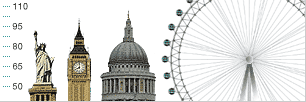
How high do you fly on the Eye?
135 metres above the London skyline - you'll be twice the height of the famous Prater Wheel in Vienna and 30 metres higher than the previous tallest observation wheel in Yokohama Bay.
The Eye is the sixth tallest structure in London; only the Canary Wharf towers (3), the BT Tower and Tower 42 are taller.
You can see up to 25 miles in each direction with views over some of the world's most famous sights, including St Paul's, the Palace of Westminster and Windsor Castle.
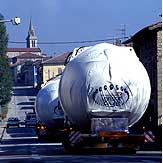
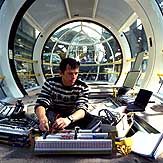
Capsules
The passenger capsules of the London Eye incorporate an entirely new design form for observation wheels. Instead of being suspended under gravity they turn within circular mounting rings fixed to the outside of the main rim, thereby allowing a spectacular 360 - degree panorama at the top.
The 32 high-tech passenger capsules can carry over 15 000 visitors per day. Enough to fill Concorde more than 150 times over.
On average the Eye makes 8000 rotations in one calendar year at a speed of 0.26 metres per second.
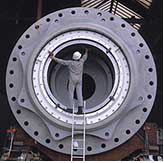

Spindle
The main elements of the hub and spindle were manufactured in cast steel. The spindle was too large to cast as a single piece so instead was produced in eight smaller sections. Two further castings, in the form of great rings, form the main structural element of the hub. The hub is a rolled steel tube forming the spacer that holds them apart. All the casting was carried out by Skoda Steel.
The weight of the spindle and hub weigh exceeds 330 tonnes, which is over 20 times heavier than Big Ben.
1 700 tonnes of steel have been used in the construction of the Eye. That's heavier than 250 double decker buses.
The total power requirement for the wheel is 500 kW, which is equivalent of six light bulbs per person if the whell is at full capacity.

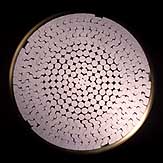
Cables
The London Eye uses two types of cable, wheel cables and backstay cables. Wheel cables include 16 rim rotation cables, and 64 spoke cables, these are similar to bicycle spokes and stretch across the wheel. There are six backstay cables, which are located in the compression foundation.
The 80 'spokes' of the London Eye use a total of six kilometres of cable - enough to run from Trafalgar Square to Canary Wharf in London.
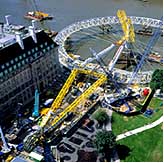
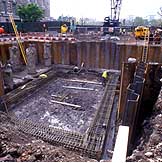
Foundations
The compression foundation is situated underneath the A - frame legs; it required 2,200 tonnes of concrete and 44 concrete piles - each being 33 metres deep. The tension foundation, holding the backstay cables, used 1,200 tonnes of concrete.